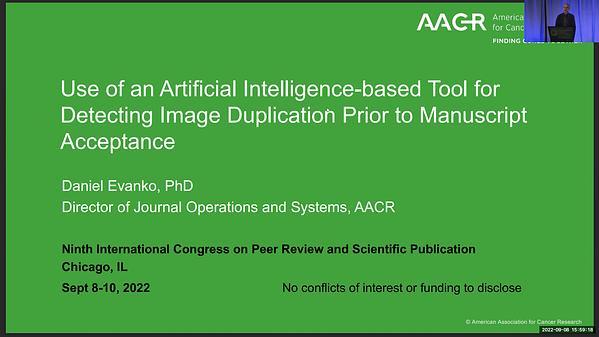Would you like to see your presentation here, made available to a global audience of researchers?
Add your own presentation or have us affordably record your next conference.
keywords:
editorial policies
misconduct
authorship and contributorship
Objective The International Committee of Medical Journal Editors (ICMJE) provided a set of minimum criteria for authorship.1 These recommendations have been adapted for all sciences in an article by McNutt and colleagues.2 The main difference between these 2 sets of recommendations is that the science-wide recommendations do not require authors to draft or revise the work.1,2 This study aimed to identify the proportion of authors who, based on their self-compiled Contributor Role Taxonomy (CRediT) statements, did not meet the minimum criteria for authorship (ie, were honorary authors) according to these 2 sets of recommendations. Furthermore, the study aimed to identify the proportion of authors who supplied only resources and/or funding to a study. Such authors were identified as “supply authors,” and this practice is considered to be a subtype of honorary authorship.
Design Cross-sectional study of CRediT statements published in scholarly articles. The Public Library of Science (PLOS) provided CRediT statements and associated data for authors of articles published in PLOS journals between July 2017 and October 2021. Two investigators independently evaluated the authorship recommendations1,2 and developed logical operations of CRediT items for each recommendation. A third investigator acted as an arbiter in case of disagreement. The criteria related to approval and accountability for both recommendations could not be verified because of current CRediT items. For the second objective of the study, authors who contributed only to roles funding acquisition and/or resources were identified.
Results A total of 629,046 CRediT statements (1 per author) originating from 82,683 journal articles were included. Of the CRediT statements, 34.8% (n = 218,563; 95% CI, 34.7%34.9%) indicated that the contributions provided by the author were not sufficient to qualify for authorship according to the ICMJE recommendations. Based on science-wide recommendations, 3.6% (n = 22,575; 95% CI, 3.5%-3.6%) of the authors did not qualify for authorship. Sensitivity analyses accounting for potentially ambiguous CRediT items provided similar results. The odds of fulfilling only 1 of the recommendations steadily decreased from 2017 to 2021 (Table 1), and authors of articles published in nonmedical journals had 1.11 times the odds to fulfill only 1 of the recommendations compared with authors of articles published in medical journals. Overall, 8394 authors (1.33%; 95% CI, 1.31%-1.36%) were “supply authors.” Their prevalence decreased in the years from 2017 to 2019 (difference in proportion, 0.6%; 95% CI, 0.57%-0.63%) but remained unchanged from 2019 to 2021 (0%; 95% CI, −0.02% to 0.02%).
Conclusions Based on self-compiled CRediT statements, honorary authorship is still prevalent in science, although it seems to have steadily decreased in recent years. A seemingly minor edit applied to the ICMJE recommendations resulted in substantially different authorship requirements. Efforts should be directed toward developing consensus on core tasks to qualify for authorship that are widely applicable in science.
Additional strategies should be implemented to address
“supply authorship.”
Table 1. Prevalence of Honorary Authorship Based on CRediT Statements Depending on 2 Authorship Recommendations and
the Association of Year and Journal Area With Disagreements
Between Recommendations

 References
1. International Committee of Medical Journal Editors (ICMJE). Recommendations for the conduct, reporting, editing, and publication of scholarly work in medical journals. Updated December 2021. Accessed February 27, 2022. http://www.icmje.org/icmje-recommendations.pdf
2. McNutt MK, Bradford M, Drazen JM, et al. Transparency in authors’ contributions and responsibilities to promote integrity in scientific publication. Proc Natl Acad Sci U S A. 2018;115(11):2557-2560. doi:10.1073/pnas.1715374115
1College of Veterinary Medicine, Cornell University, Ithaca,
NY, USA, nicoladiggi@gmail.com; 2Journal of Small Animal
Practice, British Small Animal Veterinary Association,
Gloucestershire, UK; 3Department of Oral and Maxillofacial
Surgery, Amsterdam University Medical Center, University of Amsterdam, Amsterdam, the Netherlands; 4Private practice of orthodontics, Milan, Italy; 5École de bibliothéconomie et des sciences de l’information, Université de Montréal, Montréal, QC, Canada; 6School of Electrical and Computer
Engineering, Oklahoma State University, Stillwater, OK, USA
References
1. International Committee of Medical Journal Editors (ICMJE). Recommendations for the conduct, reporting, editing, and publication of scholarly work in medical journals. Updated December 2021. Accessed February 27, 2022. http://www.icmje.org/icmje-recommendations.pdf
2. McNutt MK, Bradford M, Drazen JM, et al. Transparency in authors’ contributions and responsibilities to promote integrity in scientific publication. Proc Natl Acad Sci U S A. 2018;115(11):2557-2560. doi:10.1073/pnas.1715374115
1College of Veterinary Medicine, Cornell University, Ithaca,
NY, USA, nicoladiggi@gmail.com; 2Journal of Small Animal
Practice, British Small Animal Veterinary Association,
Gloucestershire, UK; 3Department of Oral and Maxillofacial
Surgery, Amsterdam University Medical Center, University of Amsterdam, Amsterdam, the Netherlands; 4Private practice of orthodontics, Milan, Italy; 5École de bibliothéconomie et des sciences de l’information, Université de Montréal, Montréal, QC, Canada; 6School of Electrical and Computer
Engineering, Oklahoma State University, Stillwater, OK, USA
Conflict of Interest Disclosures Nicola Di Girolamo is an editor in chief of 2 peer-reviewed journals, 1 published by Elsevier and 1 by Wiley. No other disclosures were reported.
Additional Information The protocol of this research study was registered in the Open Science Framework (https://osf.io/ezpxs/).


